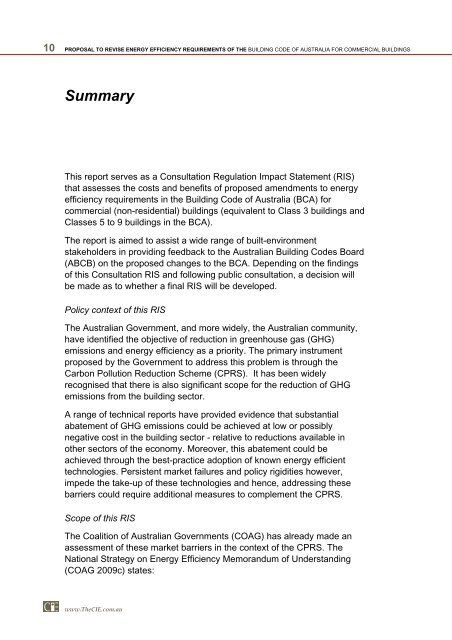PDF | 2 MB - Australian Building Codes Board
PDF | 2 MB - Australian Building Codes Board
PDF | 2 MB - Australian Building Codes Board
You also want an ePaper? Increase the reach of your titles
YUMPU automatically turns print PDFs into web optimized ePapers that Google loves.
10 PROPOSAL TO REVISE ENERGY EFFICIENCY REQUIREMENTS OF THE BUILDING CODE OF AUSTRALIA FOR COMMERCIAL BUILDINGS<br />
Summary <br />
This report serves as a Consultation Regulation Impact Statement (RIS)<br />
that assesses the costs and benefits of proposed amendments to energy<br />
efficiency requirements in the <strong>Building</strong> Code of Australia (BCA) for<br />
commercial (non-residential) buildings (equivalent to Class 3 buildings and<br />
Classes 5 to 9 buildings in the BCA).<br />
The report is aimed to assist a wide range of built-environment<br />
stakeholders in providing feedback to the <strong>Australian</strong> <strong>Building</strong> <strong>Codes</strong> <strong>Board</strong><br />
(ABCB) on the proposed changes to the BCA. Depending on the findings<br />
of this Consultation RIS and following public consultation, a decision will<br />
be made as to whether a final RIS will be developed.<br />
Policy context of this RIS<br />
The <strong>Australian</strong> Government, and more widely, the <strong>Australian</strong> community,<br />
have identified the objective of reduction in greenhouse gas (GHG)<br />
emissions and energy efficiency as a priority. The primary instrument<br />
proposed by the Government to address this problem is through the<br />
Carbon Pollution Reduction Scheme (CPRS). It has been widely<br />
recognised that there is also significant scope for the reduction of GHG<br />
emissions from the building sector.<br />
A range of technical reports have provided evidence that substantial<br />
abatement of GHG emissions could be achieved at low or possibly<br />
negative cost in the building sector - relative to reductions available in<br />
other sectors of the economy. Moreover, this abatement could be<br />
achieved through the best-practice adoption of known energy efficient<br />
technologies. Persistent market failures and policy rigidities however,<br />
impede the take-up of these technologies and hence, addressing these<br />
barriers could require additional measures to complement the CPRS.<br />
Scope of this RIS<br />
The Coalition of <strong>Australian</strong> Governments (COAG) has already made an<br />
assessment of these market barriers in the context of the CPRS. The<br />
National Strategy on Energy Efficiency Memorandum of Understanding<br />
(COAG 2009c) states:<br />
www.TheCIE.com.au
















